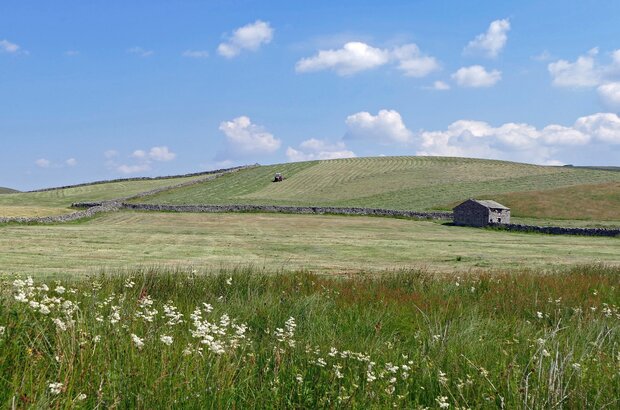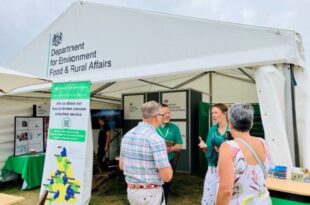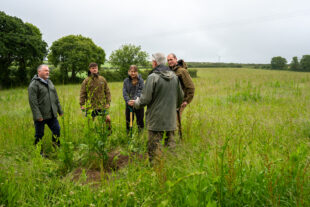
Whether you’re designing a new product or policy, testing and gradual rollouts allow teams to gather feedback, grow in understanding and make improvements in a controlled way.
From the beginning — and for all our schemes — this has been our approach.
We designed SFI with farmers, for farmers. One of the most important things that they asked for was flexibility around how to achieve the aims of the actions. They also wanted the administration to be as simple as possible. For that reason, we didn’t place limits on any actions. Rather, we wanted to see how farmers responded to the offer and evolve it as needed.
Since we opened the Sustainable Farming Incentive (SFI) for applications, we’ve continued to refine the scheme, informed by what farmers and other experts tell us, what the Rural Payments Agency (RPA) reports and what we observe through monitoring.
This has led to a number of improvements:
- we increased payment rates for SFI and Countryside Stewardship by 10% at the start of the year and doubled the SFI Management Payment
- we automated parts of the application process to save time and we’re launching a single online service for SFI and CS Mid Tier actions this summer
- we published supplementary guidance for actions. It’s there if you'd like a bit more support — it's not mandatory
All these things and many more besides, were shaped by feedback. We welcome it, we’re grateful for it and we hope new SFI agreement holders joining the 17,000 who’ve already applied will experience the benefits of those improvements.
Monitoring the amount of land taken out of food production
One of the things that we've been monitoring is the impact of the 9 actions in the current SFI offer which take land out of food production.
Through SFI, our aim is to support farming and farmers. We want to protect and improve the environment, food production and food security. We obviously don’t want SFI to be used in a way that comes at a cost to any of them.
We know that sometimes sparing land for a year, or 2 or 3 can make food production more resilient and can support farmers to achieve better margins from their land. Some of our SFI actions do take land out of food production for a short time, which helps farmers do this.
The evidence shows that a small number of farmers, roughly 1% of those who applied for SFI in 2023, entered 80% or more of their farm into actions that involve taking land out of food production.
While flexibility and freedom of choice are important features of SFI, we think this goes further than is necessary. And, in the context of economic volatility and challenging weather conditions, there is a risk that this could become more of an issue.
Limiting actions
For that reason, we’re putting an area limit on 6 of the 9 actions. The reason for limiting these 6 is that these actions were designed to be carried out on parts of the farm and smaller areas within land parcels. They are less effective if they are carried out on larger areas or whole parcels and the impact on food production is greater.
We discounted 2 of the 9 because they’re very clearly actions designed to be carried out on strips. We decided to remove one of the remaining actions, NUM3 (legume fallow) from the actions we’re limiting as it can play an important part in an arable rotation. It builds soil fertility for the next arable crop and allows farmers to control things like black grass in a way that doesn't involve chemicals.
The 6 limited area actions are:
- Take improved grassland field corners or blocks out of management - IGL1
- Winter bird food on improved grassland - IGL2
- Pollen and nectar flower mix - AHL1
- Winter bird food on arable and horticultural land - AHL2
- Grassy field corners and blocks - AHL3
- Flower-rich grass margins, blocks, or in-field strips – IPM2
From midnight tonight we’re not going to accept applications where the amount of land in total that is entered into any combination of those 6 actions is above 25% of a farm’s total land.
The aim is to ensure that we get the balance right in the percentage of a farm that we will fund to take these actions.
We’ve decided that 25% is the right level to cap these 6 actions to achieve this. Taking more land than that out of production on any given holding is unlikely to benefit the environment or food production.
We were particularly keen to act on this before the traditional point at which farm tenancies are reviewed in September.
The new approach does not apply to:
- any SFI application that's already been submitted
- SFI agreements that have already been offered to applicants
- existing SFI agreements.
Example
If the total area of your farmland is 100 hectares (ha), you can put 25ha in total in these 6 actions.
This could be 10ha of IGL2, 10ha of AHL1 and 5ha of IPM2 or any other amount as long it resulted in less than 25ha.
We need some changes in what farmers grow, including more areas on farms that primarily deliver for nature. These are often the less productive areas, and, as we’ve set out before, these areas can support food production in a variety of ways.
Learn more
Information on the limiting of those 6 actions can be found in the SFI scheme guidance on GOV.UK.
This summer, 50 new actions will be available through SFI. If limits apply to any of those actions, this will be clearly stated in the guidance.
The other actions currently on offer are not limited and the majority of land in the scheme continues to produce food. Learn more about those actions and apply for SFI today.
We will continue to monitor SFI closely and may limit other actions in the future to ensure that we maintain balance between food production and looking after the environment.
We’re about to publish another post on the take-up of SFI: who is applying, the actions they’re including in their agreements and the size of areas in the scheme, so look out for that.





22 comments
Comment by Caroline posted on
Hi,
Please can you confirm when this commences, the article says 'From midnight tonight (26 March 2024)' today is 25th March??
Thank you.
Comment by Sarah Stewart posted on
Hi Caroline,
It's from midnight tonight. I've updated the text to make this clearer.
Best wishes,
Sarah
Comment by rob yorke posted on
Hello the Team
I assume this is really more about budgetary concerns after an overgenerous uptake in the recently updated generous payment rates - rather than a direct impact on domestic food self-sufficiency levels?
best wishes
Rob
Comment by The Team posted on
Hi Rob,
We're still encouraging people to apply for SFI and we hope that the uplift in payment rates will incentivise even more farmers in England to consider it.
A few of the Sustainable Farming Incentive (SFI) actions involve taking land out of food production for a short time – for example, to provide food for wildlife or improve soil productivity. These actions are designed to be used on relatively small areas of land alongside food production.
We simply want to avoid a situation in which good farm land is taken out of production.
Best wishes,
The Team
Comment by Alison posted on
This is not a surprise. Where I would take issue is the cap on 25% of a land parcel. Where parcels are very small, it makes sense for the whole parcel to be entered . For example, I have clients with parcels of 1.5ha which lend themselves well to IPM2 and provide some great connecting habitat.
Comment by The Team posted on
Hi Alison,
The 25% limit applies to the eligible land across the whole farm, not individual parcels.
Best wishes,
The Team
Comment by Nathan Nelson posted on
Will these restrictions apply to farms transitioning to SFI from a mid-tier CS agreement?
Comment by The Team posted on
Hi Nathan,
It applies to any new SFI application (one made after Monday 25 March 2024)
Best wishes,
The Team
Comment by Denise Helen hopper posted on
A field in my village has been left wild for several years by the tenant farmer who received an EU grant for doing so.
An elecrtrified fence has recently been installed around the field in preparation for a flock of sheep to graze there. Sadly this will destroy the years of natural growth and with it much of the wildlife that has become established in the field.
The SFI Government scheme has been introduced as an incentive for farmers to continue the goal for preserving and enhancing nature.
How, if at all, can a farmer be stopped from going ahead to destroy such an area?
Comment by The Team posted on
Hi Denise,
Thank you for visiting the blog and sharing your passion for the environment in your local area.
Without knowing more about or commenting on this specific case, grazing sensitively can be an important tool for managing fields - so long as it's happening at the right time of year with the right levels of stock.
Additionally, the dung from grazing livestock provides food for a wide variety of invertebrates, which become food for birds - essentially encouraging more wildlife into the area.
An absence of grazing can have a negative effect on wildlife-rich areas, where dominant species (grasses and scrub) are allowed to take over and suppress more delicate species (herbs and wildflowers). This can take a very long time to reverse.
The Sustainable Farming Incentive pays farmers to carry out actions on their land that support the environment as they produce food. Well-managed grazing supports both those things.
When it comes to grazing, each site is unique, depending on its site, location and management requirements, there's no one-size fits all approach.
This report published by Natural England some time ago, goes into more detail: https://publications.naturalengland.org.uk/publication/68026
Best wishes,
The Team
Comment by Ian Bingham posted on
Hi,
If you want to encourage farmers to continue to produce food then it needs to be profitable to do so. Currently high input costs and weak sale prices make this impossible for most farmers even before the vagaries of the weather and the “challenges” of brexit.
Comment by William Bradley posted on
Hi. Can you please confirm or otherwise that this new restriction applies to individual land parcels?
Comment by The Team posted on
Hi William,
It applies to eligible land across the whole farm, not individual parcels.
Best wishes,
The Team
Comment by William Twiddy posted on
Hi
I think this is an understandable decision but there should be more discretion on a case by case basis. Where farms have arable land next to a watercourse then to put that into AHL1 and ALH3 makes complete sense to protect the watercourse from sediment , leaching etc and to provide a complimentary habitat right where it is needed without losing the potential for productive capacity in the future.
A one size fits all approach does not always deliver the greatest possible good and we need to get a system that is capable of a reasonable degree of elasticity where the benefits are demonstrable. A return to the days of local Natural England Offices would be a great step forwards - when we lost our local office the knowledge base that had been built up over years was broken up and lost - a great pity and a mistake I feel.
Keep up the good work - your efforts are appreciated and I hope you all have a good break over the Easter weekend.
KR
Will
Comment by Sarah Stewart posted on
Hi William,
Thank you for reading the post and sharing your views. I'll forward your comment and warm words to the SFI team.
Best wishes,
Sarah
Comment by Tom posted on
Hello
We had our SFI application accepted in Mid March but only confirmed our wish to go ahead with it yesterday. Will our application have any area limitations applied to it? We applied for more than 25% of our area to go into some of the 6 restricted options listed
Kind Regards
Tom
Comment by Sarah Stewart posted on
Hi Tom,
The limits apply to anyone who submits an SFI application from 26 March 2024. The limits won’t apply to applications submitted before 00.00 on 26 March, agreement offers made before 26 March, or any SFI agreement that’s been entered into before 26 March 2024.
Best wishes,
Sarah
Comment by Tom posted on
Good afternoon
Thank you for confirming that.
Kind Regards
Tom
Comment by Sarah Stewart posted on
No problem!
Comment by stephen posted on
Good Evening
Can I assume that you can still put your whole farm down to NUM3 even after these latest restrictions ?
Regards
Stephen
Comment by Sarah Stewart posted on
Hi Stephen,
The aim of NUM3 is to build soil fertility for arable crops in the future - it has no area limits. We encourage people to explore a combination of actions to achieve the most for both the environment and food production.
Best wishes,
Sarah
Comment by Stephen posted on
Hi Sarah
Thank you for the reply.
That’s really good because similar to AB15 in CS it’s a brilliant tool for reducing blackgrass population and increasing fertility in whole fields indeed
Blocks of land.
Regards
Stephen